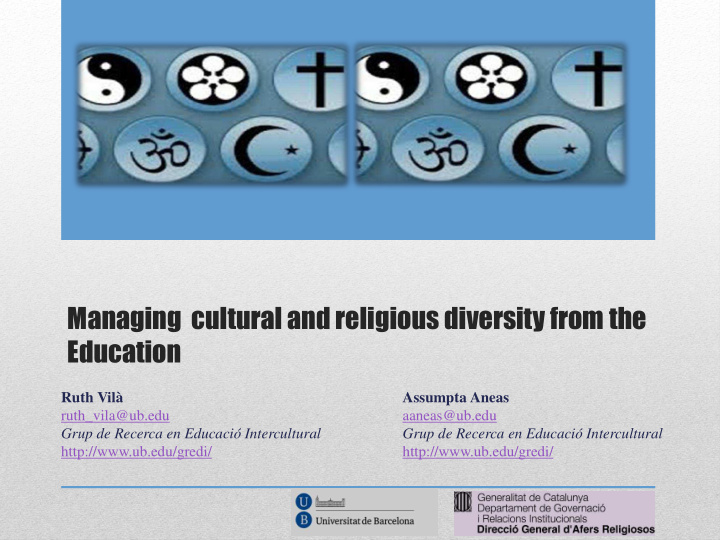



Managing cultural and religious diversity from the Education Ruth Vilà Assumpta Aneas ruth_vila@ub.edu aaneas@ub.edu Grup de Recerca en Educació Intercultural Grup de Recerca en Educació Intercultural http://www.ub.edu/gredi/ http://www.ub.edu/gredi/
Our society live in a Map of diverse diverse cultural expressions of Introduction society religious Objectives Methodology Results Conclussions Challenges for the Frequently the education and its diversity is perceived as a danger, a students problem or a identity loss
1. To Identify needs emerged for the Introduction management of the religious diversity, based Objectives on the intercultural and intereligious dialogue Methodology from the education. Results 2. To analize the attitudes of the students of Conclussions Education related to intercultural and intereligious dialogue . 3. To develop proposals for the managment of the religious diversity from the education.
Introduction Objetives Methodology Results Conclussions
NORMATIVED NEED DETECTION
Need of this management: Introduction Foment of the intercultural and discrimination, patriarchy and interreligious dialogue Objectives interreligious conflict Methodology Results Management of Conclussions religious diversity from education Need of a conceptual clarification related to the Need of actions and initiatives confessional position by the from the education secular states
• Desequilibrio • Centros de entre culto • Símbolos en hombres y mujeres el espacio • Valores público Presence in Get over alternativos al patriarcado the public the • Conciencia space patriarchy crítica • Imaginario Remove the Get over the social • Miedos y interreligio discriminati • Valores actitudes us conflicts on innegociables defensivas dificultan la • Prejuicios y resolución de discriminación conflictos • Diálogo • Diálogo intercultural intercultural Discrimination, patriarchy and inter religious conflict
Reinforce social cohesion Strengthen the work in Encourage net shared values Religious Sensibity and identity Intercultural and interreligious Dialogue
FEELED NEED DETECTION
Introduction • Objective: To Identify needs for the Objective management of the religious diversity based Methodology on the intercultural and interreligious Results Conclussion dialogue from the education. • Semi-structurated survey to: • 11 Social administration and Academic context
• Educative model at the School fairly appropiatte for the management of the religious issues from a Introduction plural approach. Objectives • Little openess to manage the religious diversity Methodology becouse: Results • Public Schools are defined theirselves as secular Conclussion • Private Schools choose an unique religion • There are other positions in neighborhoods with large plurality “ Where coexist students of diverse religious, the school trays to management the religious diversity "
• There is not an integral treatment of the Introduction Objectives religious fact. This is consequence of the Methodology missmeaning of the sucular nature of the Results european states Conclussions • There is necesary the education of the religious culture “Do not educate to students about religion means to educate future citizenship without a religious bases involved to the literature, the art, the celebrations and the coexistence.... ”
ATTITUDES OF FUTURE SOCIO- EDUCATIONAL AGENTS
Method • Survey Introduction Objectives Methodology • Pedagogía (22%), Results • E. Primaria (43%), Conclussions • E. Infantil (16%), Participants • Educación Social (9%) • Trabajo Social (11%). 574 studiants last • UB (62%), URV (20%), course UdL(14%), UdG (5%). • Index of answer 22,5%. Error 0,037.
SCALES DIMENSIONS Alpha Crombach Facilities / dificulties religious diversity Discrimination: Some religious issues as source of conflict. Religious Woman discrimination Diversity Presence at the ublic Space 0.752 TOTAL 19 Concept of religious and interreligious dialogue Intercultural and Facilities to the Interreligious Dialaogue ( Shared values, work Interreligious in net, etc) Dialogue 0.771 TOTAL 15 Formal Education Role of Other Social and Educative agents Training of future agents at the Univdersity Education 0.851 TOTAL 15 0.906 49 TOTAL INSTRUMENT Tool
• 84,8% woman and 15% man. Introduction • Average of age: 23 years. Objectives • Born in Catalonia (92,7%), Other Spain (4,7%.) Methodology Other countries (2,6% ). Results • 60,7% non believers and 39,3% believers . Conclussions • 17% think there are better religions than others. 79% think that there are religious more closer than others to interreligious dialogue SOCIODEMOGRAPHIC TRAITS
46% has received formation about 85% have not religion in other studied any settings content related to the religion Introduction in their degree Objectives 49% have experience Methodology with religious diversity Results (p.e. Practicum) Conclussions 74% think this 72% think that their formation for the promotion of formation for the promotion of interreligious interreligious dialogue is dialogue is very important not enought Formation about religious issues
Mínima Intermitja Màxima Mitja Desv. típ. N teòrica teòrica teòrica empírica empírica dim1.1 574 25,1742 3,88683 dim1.2 574 21,5470 3,53053 dim1.3 574 21,2596 4,16508 Total Escala 1 574 19 57 95 67,9808 9,35594 Introduction dim2.1 573 34,6283 5,65033 dim2.2 574 21,2160 3,36007 Objectives Total Escala 2 573 15 45 75 55,8412 8,06232 dim3.1 574 27,1864 5,29497 Methodology dim3.2 573 10,7853 2,63403 Results dim3.3 574 13,3084 3,59620 Total Escala 3 573 15 45 75 51,2583 10,22798 Conclussions • UB has the most positive attitudes • Social Education and Social Work have more positive attitudes than Pedagogy and Teachers Training • Experiences of cultural diversity are related to the positive attitude to the interreligious dialogue Attitudes
WORKSHOP
• What do you think a about these results? • Which do you think about the feeled needs in your country • Do you want to add some prescriptive needs? • Do you think in your country would be different in relation the students results?
• Which risks and challenges related to the interreligious dialogue do you think students can found in the formal educative setting? • And in the Social Networks? • Which competences for the intercultural and interreligious dialogue should have priority at secondary education?
MOLTES GRÀCIES.
Recommend
More recommend